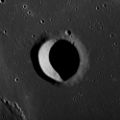 | |
| Coordinates | 4°24′N47°36′W / 4.4°N 47.6°W |
|---|---|
| Diameter | 9 km |
| Depth | 0.5 km |
| Colongitude | 48° at sunrise |
| Eponym | Eduard Suess |


Suess is a small lunar impact crater on the Oceanus Procellarum. It is a circular, cup-shaped feature with a higher albedo than the surroundings. The closest significant crater is Reiner, about 150 kilometers to the west-northwest. The lunar mare that surrounds Suess is marked by the rays radiating from the crater Kepler to the east-northeast.
The long, sinuous rille named Rima Suess begins about 30 kilometers to the east of Suess, and winds its way in a generally north-northwesterly direction for a length of almost 200 kilometers.
